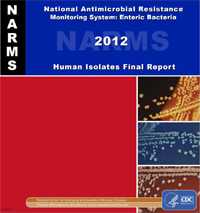The 2012 NARMS Human Isolates Report
CDC NARMS tracks antimicrobial resistance in Salmonella and other enteric (intestinal) bacteria that may cause mild or severe diarrhea or bloodstream infection. NARMS is an interagency partnership among the US Centers for Disease Control and Prevention (CDC), the US Food and Drug Administration (FDA), the US Department of Agriculture (USDA), and state and local health departments.

Bacterial foodborne infections are common and can be serious. In severe cases, the right antibiotic, also called antimicrobial agent, can be life-saving. NARMS is the only source of national information on antibiotic resistance in foodborne pathogens like Salmonella. Understanding trends in antibiotic resistance helps doctors to prescribe effective treatment and public health officials to investigate outbreaks faster.
The 2012 NARMS Annual Human Isolates Report [PDF – 88 pages, 1.48 MB] provides the most recent nationwide data and:
- Highlights antibiotic resistance changes in 2012 compared to 2003-2007 [PDF – 88 pages, 1.48 MB]
- Introduces a new method for interpreting Campylobacter data [PDF – 88 pages, 1.48 MB]
- Links to interactive graphs that allow users to visualize the percentage of NARMS human isolates resistant to antibiotics, by year up through 2012
Key Trends in 2012
To determine trends, NARMS compared 2012 to the average percentage of resistance during the first five years (2003-2007) that it conducted nationwide surveillance. Some overall trends moved in the right direction; others were worth concern; still others were disturbing.
Right Direction
- Multi-drug resistance in Salmonella declined over the last ten years
- 2012: 9%
- 2003-2007: 12%
- Resistance to two important groups of drugs remained rare, but notable
- 2012: ceftriaxone at 3% and quinolones at 2.5%
- 2003-2007: ceftriaxone at 4% and quinolones at 2%
Worth Concern
Did You Know?
Shigella rapidly tends to become resistant to drugs used to treat it.
-
Campylobacter resistance to ciprofloxacin remained at 25%
- Where it has remained since 2006, the year that the FDA halted the use of these drugs in poultry
-
Shigella resistance to ciprofloxacin (2%) and azithromycin (4%) is growing
- However, only one Shigella strain tested was resistant to both drugs
- About one in five Salmonella Heidelberg infections were resistant to ceftriaxone, a cephalosporin drug
- Same Salmonella serotype that has been linked to recent outbreaks associated with poultry
- Ceftriaxone resistance makes severe Salmonella infections harder to treat, especially in children
-
Salmonella Enteritidis – the most common Salmonella serotype – accounted for 50 % of infections resistant to nalidixic acid (the quinolone drug which is used in laboratory testing for resistance)
- Fluoroquinolone resistance remained low in 2012
- Resistance to nalidixic acid relates to decreased susceptibility to ciprofloxacin, a widely used fluoroquinolone drug
- Other work shows that many of the nalidixic acid resistant Salmonella Enteritidis infections are acquired during travel abroad
Disturbing News
Resistance of Salmonella Typhi to commonly-used treatment drugs increased significantly
-
Salmonella Typhi (the germ that causes typhoid fever) resistance to a quinolone drug increased to 68% in 2012
- Raising concerns that ciprofloxacin, a drug in the fluoroquinolone drug class and a common treatment for typhoid fever, may not be as effective
- NARMS did not find ceftriaxone resistance in the Salmonella Typhi that was tested
Improved Monitoring
Globally harmonized tracking. Many countries track antibiotic resistance differently. In 2012, NARMS adopted a new international measure for Campylobacter resistance now used by many other countries. Using Epidemiological Cut-Off Values (ECOFFs) [PDF – 88 pages, 1.48 MB] is a step toward globally harmonized methods for tracking antibiotic resistance in Campylobacter.
Related Pages
- The World Health Organization’s categorization of antimicrobial agents of critical importance to human medicine (Appendix A, Table A1[PDF – 93 pages, 1.47 MB])
- Antibiotic / Antimicrobial Resistance
- Antibiotic Resistance Threats in the United States, 2013
- Federal antibiotic resistance budget initiative
- Interagency Task Force on Antimicrobial Resistance
- Detect and Protect Against Antibiotic Resistance: CDC’s Initiative to outsmart this threat
- Page last reviewed: July 1, 2014
- Page last updated: July 16, 2014
- Content source:



 ShareCompartir
ShareCompartir
